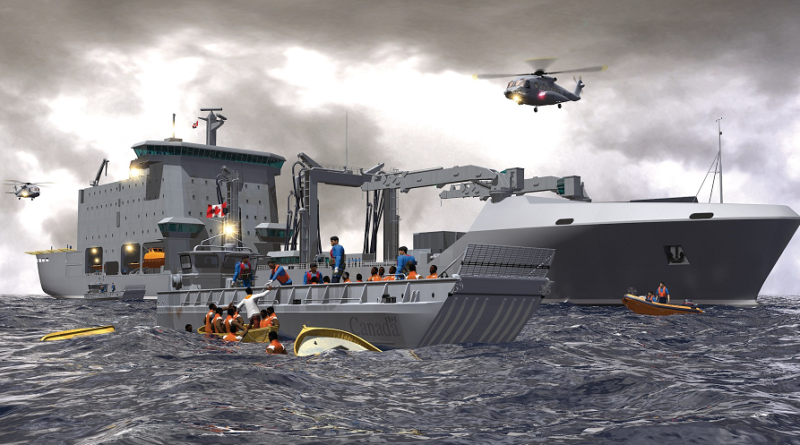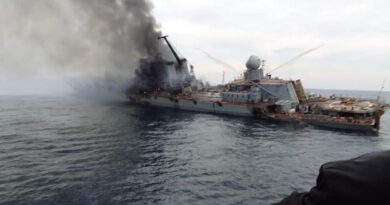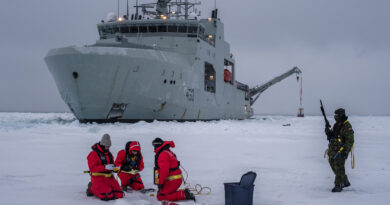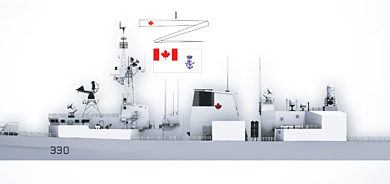MV Asterix and HADR Missions
Motor Vessel (MV)1 Asterix was converted by Chantier Davie from a container ship to a replenishment oiler2 for the Royal Canadian Navy under the Interim Auxiliary Oiler Replenishment (iAOR) project. The ship has a civil master and crew, and embarks military personnel to operate specific equipment. Whilst most combatant warships can serve to some extent for humanitarian assistance/disaster relief (HADR) missions3, naval auxiliary vessels such as Asterix are particularly suited because of the how they are configured and equipped.
The following4 are capabilities fitted in Asterix useful for HADR missions:
1. Carry up to 20 refrigeration (reefer) controlled TEU (twenty-foot equivalent unit) containers;
2. Carry up to 18 TEU in a heating-ventilation-air-conditioning (HVAC) controlled environment for other cargo (may be ammunition or other cargo as required for the mission);
3. Carry up to 12 TEU mounted on deck (no HVAC/reefers);
4. Carry fifty sea containers of relief goods, with two 30 ton cranes that afford operational flexibility;
5. Provide limited medical treatment with separate medical sanitation and ventilation systems (NATO Role 1, medical and dental);
6. Transport and deploy a containerized field hospital ashore and house support staff on board;
7. Transport a military field hospital medical facility and/or field kitchens to support operations away from the ship;
8. Limited transport of wheeled vehicles or other cargo in the Tween Deck;
9. Fueling alongside or at sea of F76 (ship) and F44 (aviation fuel);
10. Supply potable water alongside or at sea. Can produce over 100,000L of potable water a day at sea;
11. Supply 6,000 kW (6mW) of power;
12. Helicopter support for transfer of personnel and supplies, and for medical evacuation (medevac);
13. Use rigid-hill inflatable boats (RHIB) for security patrols or delivery of supplies;
14. Embark additional boats (RHIB, Land Craft Vehicle Personnel – LCVP) to deliver supplies, etc.;
15. Provide rear support for military personnel ashore;
16. Operate operations room with civilian and military communications;
17. Provide 500 meals per hour that can be taken ashore;
18. Operate commercial grade laundry facilities to support afloat and ashore contingents; and
19. Provide force protection (security);
The following4 are capabilities for which Asterix is ‘fitted for but not with’ (FFBNW):
1. Expanded medical treatment facilities;
2. Additional bunking for either military personnel or for evacuees (up to 148 additional bunks in FFBNW HADR dormitories);
3. Additional bunking in Tween Deck cargo area (up to 150 additional, however, no climate control);
5. Carriage of ship-to-shore connectors such as modular powered barges5;
6. Reinforced deck for two LCVP;
7. Carriage of gasoline to fuel vehicles, generators, etc.;
8. Command and control facilities and/or additional office space for coordination of shore based operations; and
9. Dedicated rooms for non-government organization (NGO) staff.
For a video about Asterix and HADR, see: “Resolve: Helping Canada Help Others”.
Notes:
1. Civil ships by convention often have their propulsion (e.g., MV or mv or m/v, meaning motor vessel) or role (e.g., RV meaning research vessel) prior to but not part of their name.
2. See “Auxiliary Oiler Replenishment” http://rusi-ns.ca/auxiliary-oiler-replenishment/ for a description of AOR capabilities.
3. Non-combatant evacuation operations (NEO) can be considered a HADR mission.
4. Information courtesy of Federal Fleet Services, operators of Asterix.
5. In the military of the United Kingdom, such barges are known as mexeflotes (see “What is a Mexeflote”).




